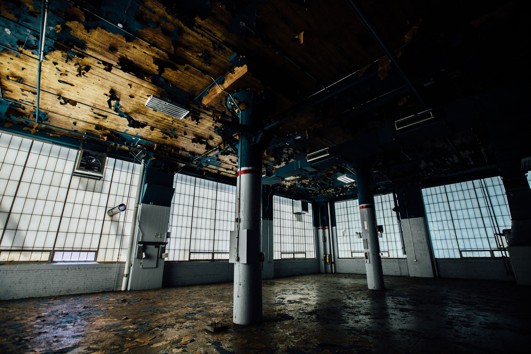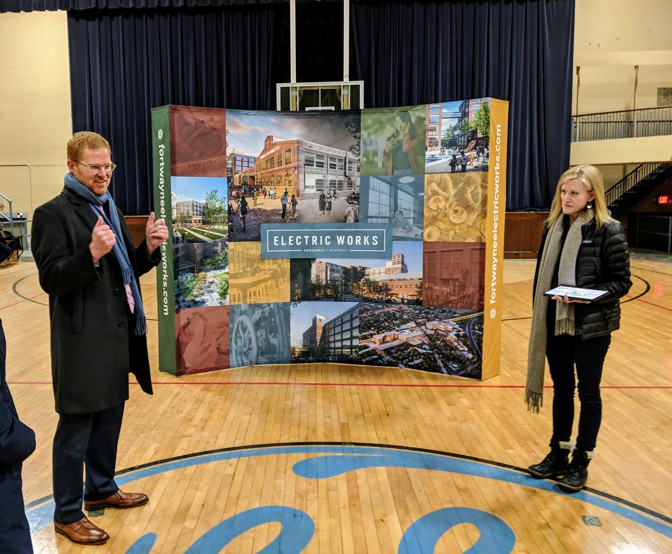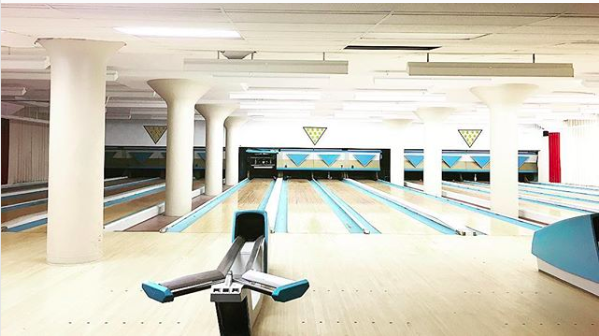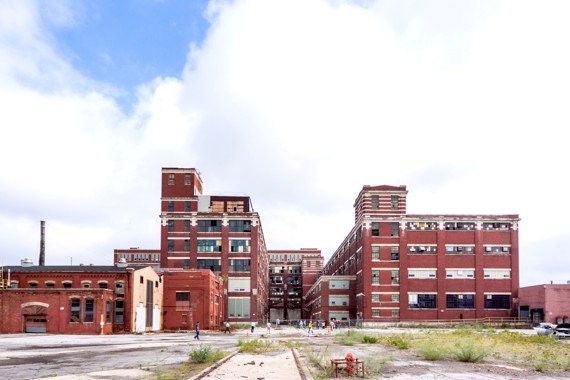Today’s theme: what happens to buildings, after they die.
Today’s locale: a major manufacturing center along Indiana’s I-69 corridor, the industrial stronghold of Fort Wayne.
The second lives of buildings—or third, or fourth or tenth—after they’ve outlived their original economic or civic purpose, is a topic that has commanded Deb’s and my attention more and more, with each new American venue we spend time in.
- If a city is unlucky—or shortsighted, which often turns out to be the same thing—it bulldozes its architectural heritage of the past decades or centuries, for whatever is the fad of the moment.
This happened, disastrously, to my small home town of Redlands, in inland Southern California. In the late 1960s, when freeway-based sprawl-malls were just beginning to hollow out downtown retailers, a short-sighted city leadership made a choice that the city has yet fully to recover from. It approved razing about half of the downtown’s historic business structures—shops, civic clubs, a famed 1930s-vintage hotel—to make room for one of that era’s Brutalist/penitentiary-style in-town malls, surrounded by parking lots. Nearly 50 years later, that mall stands abandoned and bankrupt, its only activity a national-chain drugstore that clings to its long-term lease. (For locals: I’m talking about the former State Street west of Orange Street; the structures on State Street east of Orange were spared.)
Meanwhile, the other half of the Redlands downtown, the part that was spared the wrecking ball, went through its 1970s and 1980s of hard commercial times. But the buildings survived; starting 10 or 15 years ago they began attracting new activity; and now they constitute one more of the nation’s vibrant smaller-city downtowns, working around the decayed molar of the mall.
Time and again we’ve seen evidence of cities that made the same mistake. Here’s an easy way to spot them: When you see a break in the downtown architecture of a mid-sized city—when a classic early-20th-century office building, or an Art Deco facade from the 1930s, suddenly gives way to a multi-level downtown parking garage—odds are you’re seeing the physical legacy of civic short-sightedness half a century ago.
- If a city is luckier, or if it was less energetic in the mid-century build-a-mall era, it will have left its original architecture in place. The shops may have been boarded up or concealed beneath aluminum siding. They may be doing duty as pawn shops or worse. They may seem beyond hope. But as long as they exist, they lie waiting and full of potential, like wildflower seeds in the desert waiting for the eventual rain.
The Main Street America project, which is based in Chicago and originated with the National Trust for Historic Preservation, keeps a master list and coordinates downtown renewal efforts. We’ve seen examples from South Dakota to Kentucky to Oregon to Florida, and places in between. (For instance: our previous report, on Angola, Indiana.)
- If a city is willing to make its own luck, and is foresighted, it will begin purposefully refitting its old structures for new roles. This has become a nationwide trend. In the fastest-growing big tech centers, practically any structure that was once a warehouse or a machine shop has returned as a new office space, startup zone, hotel or condo, or brewery or restaurant.
It is happening in smaller places too. Five years ago, our colleague John Tierney wrote about the reincarnation of the old Mack Truck works in Allentown, Pennsylvania, as a research and startup center. Not far from Allentown, in Bethlehem, the spookily beautiful abandoned U.S. Steel works have become a concert center and arts venue. Something similar has already happened in Birmingham, Alabama, with the former steel mill known as the Sloss Furnaces; and is underway in Danville, Virginia, with former tobacco warehouses (on the model of Durham, North Carolina, with the old American Tobacco works); and is envisioned in tiny Eastport, Maine, with what had been the East Coast’s biggest sardine cannery; and on through what could be an endless list.
Former places of worship whose congregations have dwindled are also undergoing this process. Yesterday I mentioned how a former church in Angola, Indiana, has been converted into a new performing arts center. The ambitious Jefferson Educational Society, a civic think-tank in Erie, Pennsylvania, has its headquarters and public events in a former synagogue. The St. Joseph brewery, in Indianapolis, operates (and seats patrons) in what was once the St. Joseph church.
Fort Wayne is now attempting to make its own luck, with the remains of what had been its grandest industrial site.
Fort Wayne is the second-largest city in Indiana, after Indianapolis. On the I-69 route along which Deb and I traveled (with our colleagues from New America-Indianapolis and Indiana Humanities), it’s about 40 miles south of Angola, and 120 miles north of Indianapolis. Demographically it is more diverse than its state: African-Americans make up about 15 percent of Fort Wayne’s population, versus under 10 percent for Indiana statewide (and well over 70 percent for Gary, bordering Chicago). Even within a state whose overall economy is manufacturing-based, Fort Wayne has exemplified the major-factory town.
And through Fort Wayne’s modern history, no major factory was more major than GE’s enormous Broadway works.

The first manufacturing facility on this site opened in 1883, as part of the then-revolutionary technology of electric lights and motors. By the beginning of World War I, GE had established its Fort Wayne Works there, and over the next fifty years it dominated the city’s economy and culture. At the peak of World War II production, some 20,000 people worked for General Electric. A post-War GE promotional booklet said that nearly 40 percent of the city’s workforce was on the GE payroll at the time. The booklet said of GE’s robust payroll, “These millions of dollars represent not only the earnings of General Electric employees in this locality—they are a vital force that helps make vigorous the life of this community.”
The campus covered 39 acres, with well over a million square feet of floor space in more than a dozen buildings. One of these buildings, #26, was the largest structure in all of Fort Wayne when it went up.
You already know what’s coming: fifty years of expansion were followed by fifty years of decline. The manufacturing payroll at the Fort Wayne plant went from nearly 12,000 at the end of World War II, to 7,000 in the early 1970s, to 2,000 in the late 1990s, to no one now.

For years, what had been the heart of the city sat, rusted, and fell apart. It wasn’t bulldozed or torn down. But the floors buckled, and the skylights fell in. The interior walls grew mottled with mold, and the exterior ones attracted graffiti. The surrounding neighborhood, that had grown up with the factory, went down with it. Cities are more than physical structures, but we heard several times how the fate of the Fort Wayne Works unavoidably seemed to symbolize travails for the whole town.
That is where a $400+ million project called Electric Works comes in.
On a raw, blustery day in March, I put on the requisite hard hat, safety glasses, yellow vest, and similar gear for a tour of the abandoned GE plant, now re-christened Electric Works. Crystal Vann Wallstrom, who came from San Francisco and has become Managing Director of Innovation for the Electric Works project, toured me (carefully) across the uneven floors and up the crumbly stairs and around the project’s construction crews. With me on the tour was Adam Thies, a city-planning specialist who has worked, among other places, in Angola, Indiana (but who has no official connection with Electric Works).

What she they pointed out to me was, in one sense, very much like structural-renewal projects I’d seen or heard about elsewhere: Vast old work spaces, their original economic purpose gone, being prepared for a new life meeting new needs. You can read the details about the Electric Works ambitions here. In brief, the new campus is intended to have residential lofts; creative office space; medical research labs; a primary-care health facility (in a medically underserved neighborhood); restaurants and a huge new farmer’s market area (in a “food desert” part of town); and more. It aims to have hotel and residential facilities, the restored 1926 gymnasium and 12-lane bowling alley, a climbing gym plus “adventure park,” and … other features you can read about on their site.
Jeff Kingsbury, of the RTM Ventures firm that is the lead private financier of the site, emphasized that it was explicitly drawn from models that have proven successful in other mid-sized industrial towns. “We’ve seen this strategy happening all around the country,” he told me, in a phone call. “You’ve got these mixed-use walkable places that are designed to connect and attract people, and foster innovation. People are aware that the old suburban research-park model no longer makes sense. You want to make your talent want to stay in town, because there are cool and enjoyable things to do.”
I realize that talk of “fostering innovation” and “connecting people” inevitably sounds like platitudes; but Kingsbury gave illustrations, which I’ve seen around the country too, of such an approach paying off. “In terms of having a big, old legacy industrial campus, and trying to repurpose it, what’s happened in Durham is probably most similar.”

If these and other factors make the Electric Works ambition recognizable from other (successful) projects in other mid-sized towns, what makes it distinctive? Again with the “show your homework” caution that these are first impressions, subject to later revision, here are four that struck me.
- The Hoosierness of it all. When I walked in the front door of the main Electric Works office building, I felt as if I were on a set for the old movie Hoosiers. It was a classic old indoor basketball court built in the 1920s, with ranks of folding seats on both sides. It is preserved from the days when GE company teams would play there. A swirly GE logo is painted on the center of the hardwood floor.
“You might have heard that Indiana is basketball-crazy,” said Adam Thies—just before he took off his suit jacket, stepped to around the three-point line, and took a jump shot, which swished in. “Nice one!” I said. “My jump shot is just average,” he replied, aw-shucks style (and also implying: just average—for someone from Indiana.) Later that day I heard a related “fact” that, as it is backed up by Wikipedia, I’ve decided is too good to scrutinize further: of the 10 biggest high school gyms in the United States, for watching basketball, nine are in Indiana. The Fort Wayne Works definitely had a sense of place.
In the same headquarters building is a 1950s-look classic bowling alley, that appears to have been the scene of an alien abduction. Unlaced bowling shoes and score pads sit on locker-room benches, pins and bowling gloves are on the counter. It is as if the GE bowling team vanished all at once, or if someone took the Bowling Alone hypothesis super-literally.

- The scale of it all, both physically and conceptually. A million square feet of office space looks even bigger than it sounds. When industrial buildings are full of giant metal-working machines and forklift trucks, you can lose sight of their scale. When I was reporting in China, I often wished I had a way to allow readers to see the extent of the factories, the staff dormitories, the shipping docks. Fort Wayne is working on a larger canvas than I had imagined before looking at this site.

Part of the new Electric Works project. (Courtesy of Electric Works.)
- The complexity and care of civic engagement. The funding of this project is an epitome of “public-private partnership”—a phrase that, as I’ve noted before, is seen in Washington as a euphemism for “payoffs” or ‘log-rolling,” but at the local level appears to be a key ingredient in getting things done. Some of the money is private investment; some is municipal bonds; some is federal and state tax incentives; some comes from a community foundation; some comes from elsewhere. I’m deliberately not giving the numbers because they’re complex, and if you want a precise breakdown, you can go here or here (click on “How is this project being financed?”)
The surprise to me was evidence provided by Electric Works on the breadth of community support—across race, and income level—for the idea of spending public money to revive this site. Last year the polling firm Campos did a study of local attitudes toward this expensive new project. The resulting Journal-Gazette story is here, and the full report is downloadable as a PDF here.
Among the findings were 84 percent of respondents agreeing with the statement, “Electric Works is a good example of the old saying that sometimes you have to take a small risk to secure a big return.” Some 81 percent said they agreed with, “Electric Works will be successful in making Fort Wayne and Allen County a better place to live, just like other public-private partnership investments in our community have.” By the same 81 percent, respondents agreed that “Fort Wayne and Allen County are moving in the right direction. The Electric Works development just moves us farther along the right path.”
“The emotional weight that the industrial complex has on this community can’t be overstated,” Josh Parker, of RTM Ventures, told Claire Ballentine of Bloomberg just this month. “It’s not just what we’re doing on our site, but what that brings to the larger area.”
The project has its critics and controversies (as described in the Journal-Gazette here), and it has not yet nailed down all its funding. But leaf through the poll and compare its results with anything you have heard about national-level politics recently.
- “I was a dweller.” Crystal Vann Wallstrom had been working and living in San Francisco for 15 years before she moved to Fort Wayne, where her husband had gotten a job offer.
“Frankly, I was a petrified to move here—I mean, to Fort Wayne, from California,” she told me. “But we have loved it, and being here has made us rethink our perceptions of ‘the Midwest.’” Vann Walstrom said that in San Francisco, she and her husband had been raising their two toddlers in a 325-square-foot rented studio apartment in the Mission district.
“When house prices are in the seven figures, you reconsider your priorities,” she told me. She said that for the same cost as her studio in the Mission, she and her husband are raising their children in “a 2,600 square-foot house, in a historic neighborhood, on an acre of land, eight minutes from downtown. We are homeowners for the first time, in our 40s.”
She made another point, too. “I realized that in San Francisco I was a ‘dweller.’ I was just living there. Now I feel as if I’m helping build a community.”
Will this all work, in the way the project’s backers promise and many local residents clearly hope? I don’t know. The point for now is the breadth, density, and boldness of experimentation, largely outside the national view.
Next stop: another site on I-69.

No comments:
Post a Comment